Journal Indicators:
CiteScore 2024 1.0
IF 0.8
H-index 19
SJR 0.265
Points on list of rated journals of the Ministry of Education and Science 40 (punkty z oficjalnej listy Ministerstwa Edukacji i Nauki )

This issue of Photonics Letters of Poland presents a diverse collection of photonics research, ranging from signal processing in optical fiber sensors to nonlinear optics, the dynamic laser speckle technique, and microwave engineering. Tresna et al. demonstrate how Fast Fourier Transform in Python can effectively denoise LSPR spectra, improving heavy metal detection. Kasztelanic et al. explore second-order nonlinearity in alkali-glass fibers, revealing promising results for nonlinear photonic applications. Li et al. propose a liquid crystal-based delay line for millimeter-wave systems, offering stable dispersion control across a wide frequency range. Patel et al. present a novel and cost-effective approach for detecting low-level adulteration in commercial honey, which is highly relevant for practical applications in food authentication and quality control.
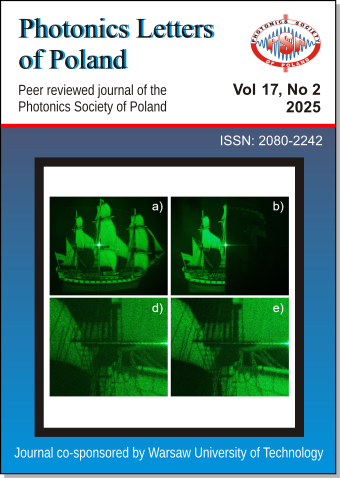
This issue of Photonics Letters of Poland presents a diverse collection of photonics research, spanning holography, spectroscopy, fiber-optic sensing, and environmental monitoring. Each contribution presents innovative approaches to solving real-world challenges using advanced photonic technologies. Specifically: (i) A comparative study of phase-only hologram encoding methods reveals that Direct Phase-only Holograms (D-PoH) offer the best performance for wide-angle displays. The paper also proposes improvements to the Complex Amplitude Modulation (CAM) method to address its limitations in brightness and image quality. (ii) Raman spectroscopy, supported by SEM imaging, is used to analyze and identify the composition and morphology of unknown human kidney stones. This non-invasive technique demonstrates strong potential for clinical diagnostics and personalized treatment planning. (iii) Investigations on microplastic emissions from nail styling materials, identifying particles with allergenic and potentially harmful properties, is presented. The findings underscore the need for exposure assessments and emission control strategies in enclosed environments like beauty salons. (iv) A PVDF-coated Fabry–Pérot fiber-optic sensor is introduced for detecting PFAS in water, showing reversible spectral shifts and high repeatability. Its low cost and portability make it ideal for in situ environmental monitoring. (v) The spatial modulation of the pump beam enabling lasing in cholesteric liquid crystal layers is also presented. It also shows the feasibility of dynamic optical data recording on thin laser-active layers. (vi) A hollow-core photonic crystal fiber sensor combined with deep learning achieving 96.3% accuracy in detecting lung cancer from exhaled breath is shown. This approach offers a promising path toward portable, non-invasive early diagnostic tools. (vii) A V-grooved, gold-coated photonic crystal fiber sensor operating in the NIR range exhibiting exceptional sensitivity and resolution for tumor detection is studied. Its optimized design ensures minimal loss and high efficiency in distinguishing healthy from cancerous tissues. (viii) Theoretical modeling of a graphene light source integrated with a silicon membrane reveals its potential as a miniaturized, tunable IR emitter. The study explores spectral tuning capabilities based on membrane deflection and device geometry.

This special issue, dedicated to the 21st Conference on Optical Fibers and Their Applications (OFTA 2025), taking place in Białystok, Poland, in January 2025, consists of 10 papers. Specifically, the paper on the fabrication and properties of Erbium-doped Gallo-Germanate glass thin films via RF-sputtering explores the potential of Er³⁺-doped thin films for integrated optics emission sources. Research on Europium-doped nanocomposite TiOx:SiOy layers demonstrates how Eu³⁺ ions reduce optical losses by affecting crystallization and surface roughness. Luminescent monitoring of Eu³⁺-doped 13-93 bioactive glass fiber degradation investigates the degradation rate using luminescence monitoring. The investigation of neural networks for temperature and relative humidity measurement with Rayleigh scattering-based distributed optical fiber sensors evaluates neural networks for processing sensor data. The effect of CO₂ laser-induced crystallization on ErF₃-doped tellurite-germanate oxy-fluoride glass examines structural and luminescent enhancements induced by CO₂ laser irradiation. Enhanced sensitivity of absorption spectroscopy glucose detection by machine learning shows the effectiveness of UV-VIS spectroscopy and machine learning in detecting low glucose concentrations in urine samples. Machine learning-enhanced optical fiber sensors for detection of low glucose concentration in samples mimicking tissue present an optical fiber sensor enhanced by machine learning for accurate detection of low glucose concentrations. Investigation of the luminescent properties of SiLiZn glass-ceramic phosphor doped Cr³⁺/Cr⁴⁺ explores the development of Cr²O₃-doped glass-ceramic phosphors for broadband NIR emission, targeting applications in NIR pc-LEDs. Broadband emission in the near-infrared range in glasses doped with PbS quantum dots and Er³⁺ ions showcases borosilicate glasses co-doped with PbS quantum dots and Er³⁺ ions for broadband NIR luminescence. Finally, the ratiometric optical laser power sensor based on a polymer luminescent nanocomposite presents a ratiometric optical laser power sensor using a polymer luminescent nanocomposite for inexpensive laser monitoring systems.
In addition, two other papers are included in the issue. The paper on the near-infrared image-based method for vision enhancement in monitoring the structure and emission character of operating phosphor-converted white light-emitting diodes (pcW-LEDs) demonstrates how incorporating infrared filters significantly improves the observation of pcW-LEDs during operation, reducing glare and enhancing emission efficiency evaluation. The second paper, reconceiving impedance matching and mismatching to mitigate bias-drift in insertion loss of liquid crystal phase delay lines, proposes a novel hardware approach to address amplitude imbalance in phased array antenna feed systems, thereby reducing performance degradation and maintenance costs without relying on conventional amplifiers or attenuators.

The current, 64th Photonics Letters of Poland issue (Vol. 16 No. 4) contains 9 papers related with the research activities of the Photonics technologies – one of seven Priority Research Areas identified by Warsaw University of Technology within the “Excellence Initiative – Research University” Program and 1 regular paper.
The idea behind the Excellence Initiative – Research University Program carried out in the years 2020-2025 was to select the best Polish universities and provide them with an opportunity to grow so that, in the future, they can be ranked among renowned universities all over the world. Priority Research Area Photonics technologies at Warsaw University of Technology has been focused on design and manufacturing of optical components and novel photonic materials as well on the development of innovative technologies and measurement methods in the following areas: fiber optic photonics, laser and terahertz technologies, photonic integrated circuits, optoelectronic devices and systems, photonic sensors and metrology, multispectral image processing.
The diversity of the selected works reported in the current issue covers a significant spectrum of technology, photonic material, systems, and devices:
Mazur et al. presented the first results of applying the phase-shifting method to recover phase information in a full-field swept-source Optical Coherence Tomography system operating in transmission mode.
Budaszewski experimentally investigated birefringence of the ferroelectric liquid crystal doped with titanium dioxide nanoparticles.
Fetliński et al. investigated feasibility of average photon energy parameter as a qualitative representation of solar spectra in modelling performance of photovoltaic modules equipped with a filter capable of reflecting parasitic IR irradiance.
Cywińska et al. discussed the influence of the noise on the resultant local fringe orientation map estimated via DeepOrientation network.
The paper by Orzechowski et al. discussed blue-phase liquid crystal composites with shelled gold nanoparticles.
Dudek et al. presented the autofocusing method for lensless digital in-line holographic microscopy with misaligned illumination whereas Niedziela et al. described pixel super resolution with axial scanning in lensless digital in-line holographic microscopy.
Sobczyk et al. presented THz based non-destructive testing system for security and inspection applications whereas Kałuża et al. discussed challenges and limitations of THz phase imaging method.
Tomasz R. Woliński
Priority Research Area Photonics technologies Chair

Different aspects of optics and photonics, like, fine-element adaptive meshing statistics of liquid crystal coaxial phase shifters at mmW and THz frequencies; numerical analyses to check how the core shape influences the quality of fiber sensors based on D-shape fibers; investigations of how the synthesis route of glass-ceramic doped with europium ions influences their optical and luminescence properties; implementation of convolutional neural networks in a virtual optical system for wavefront detection with potential application in visual optics; the role of standard and supplementary observers in accurate illuminance measurements; utilization of commonly available UVC diodes for deactivation of the SARS-CoV-2 virus.

In this issue, seven papers are presented, highlighting the advancements in optical and photonic technologies, demonstrating their potential in environmental monitoring, high-power applications, medical diagnostics, industrial metrology, and optical fiber sensors. Specifically, the critical points of the papers are: (i) investigations on input parameters of optical scattering, particle size and material, excitation laser, and refractive index of the medium, assisted by machine learning aimed particle characterization concerning microplastic pollution; (ii) development of a laser system dedicated to high-power applications and based on an in-house developed Yb3+ doped silica fiber with a large core, achieving a maximum output power of 107 W; (iii) design of a Photonic Crystal Fiber (PCF) sensor, leveraging guided-mode resonance and integrating a specific biomarker, for accurate and early-stage detection sensitive of tumor cells in cerebrospinal fluid; (iv) application of short wavelength infrared absorption spectroscopy for detecting methane and ammonia, addressing the current needs of industrial gas metrology; (v) proposal and verification of the method for modeling the emission of yellow phosphor YAG:Ce3+ based on the Gaussian function; (vi) a concept and numerical analysis of a fast scanner that combines a planar waveguide with a grating coupler and a swept source laser to be applied in PICs, (vii) a new method for fabricating fiber optic sensors based on D-shape fibers with an elliptical core. This innovative approach maintains a polarized state and enhances the performance of optical fiber sensors.
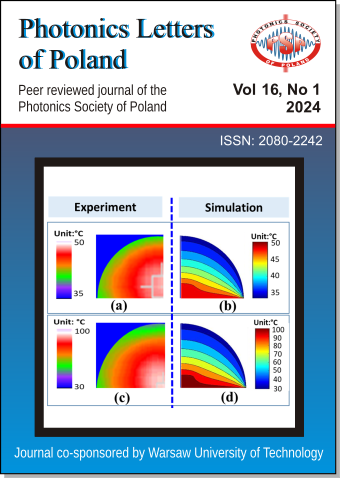
In the current issue of the Photonics Letters of Poland, one may find six papers related to different aspects of widely defined optics and photonics, including: the study of NIR luminescence in barium gallo-germanate glasses and antimony-germanate glass ceramics co-doped with bismuth, chromium, and with different lanthanide ions, respectively; investigation on the temperature dependence of the spectral characteristics of LED sources used in outdoor lighting; experimental studies on thermoelectric cooler-based thermal management method for improving the performance of LEDs; theoretical studies on the steady-state thermal model for white light LEDs thermal management application at encapsulant level; work on low-cost modular microscope with white LEDs for measuring fluorescent diamonds.
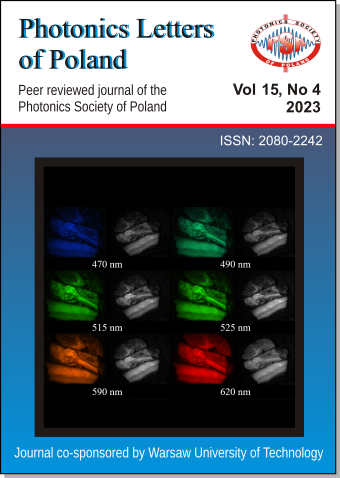
In the current issue of the Photonics Letters of Poland, one may find ten papers related to different aspects of photonics, including a variety of topics like: the realization of the tunable delay lines in the microwave regime utilizing the polarization and incident angle dependencies of azo-admixed liquid crystals (LCs); mathematical model for emission spectrum of white LED light sources with Gaussian function; studies on the current-voltage characteristics of n-CdSe/p-Si heterostructures; the optical E-band use in the NG-RAN/O-RAN radio signals transmission over optical distribution networks path; considerations on the dynamics of dark spatial solitons using a microscopic model based on the photorefractive transport equations; studies on the temperature effect on the luminescence profile of photonic materials for biological applications; method for evaluation of the optical uniformity distribution in the white LEDs-based visible light communication applications; model for studying the luminous flux behavior of phosphor-converted white LEDs; application of tunable LED illumination for biological tissue imaging; analysis of amplified spontaneous emission in ring-core Tm3+-doped optical fiber.
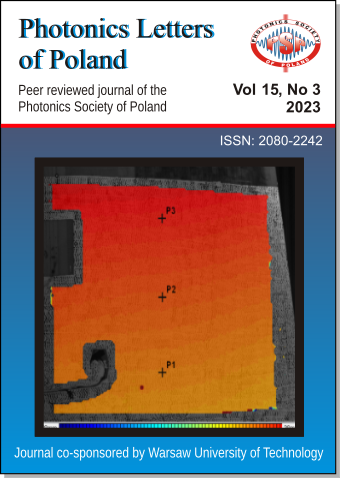
In the current issue of the Photonics Letters of Poland, one may find six papers related to different aspects of photonics like: 1) the generation of highly confined focal spots with extended focal depth with the use of azimuthally polarized Lorentz Gaussian vortex beam; 2) application of fiber optic sensors utilizing machine learning algorithms for temperature measurement of lithium-ion batteries; 3) using Digital Image Correlation as an optical full-field technique to provide precise and accurate identification of the character of the load applied to elements under test in the industrial environment; 4) discussion on the technological challenges of silica-titania thin film deposition via a simple and cost-effective sol-gel process and dip-coating method; 5) simulation and analyzes of four organic and inorganic materials performance to be utilized as hole transport layer in the design of germanium-based Perovskite Solar Cells; 6) synthesis, grown and characterization of 3ACPM single-crystal as a prospective option to be applied in the field of nonlinear optics.
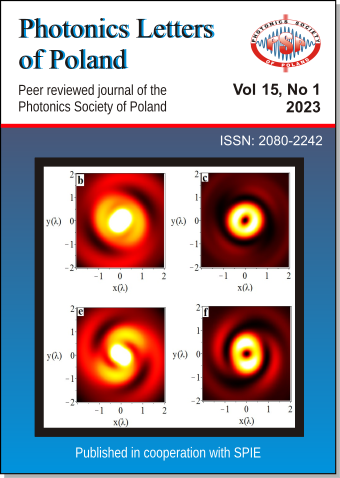
The current issue of Photonics Letters of Poland features papers related to various aspects of photonics, including: the design of optical sensor for water turbidity to obtain precise water quality values without interference from outside light (unlike previous studies using conventional turbidity sensors); extraction and optical characterization of silica from reeds biomass in various annealing temperatures indicating a shift of the optical properties and dielectric functions towards longer wavelengths with an increase of annealing temperature; theoretical demonstration of the electric and magnetic energy densities and energy flux for radially variant vector beam focusing through a dielectric interface to generate novel focal structures for corresponding radial indices; the design of apodizer which significantly improves the performance of three-zone aberrated optical systems by increasing the intensity and suppressing the side lobes for higher degrees of defocus and primary spherical aberration thanks to application of specific amplitude filter.
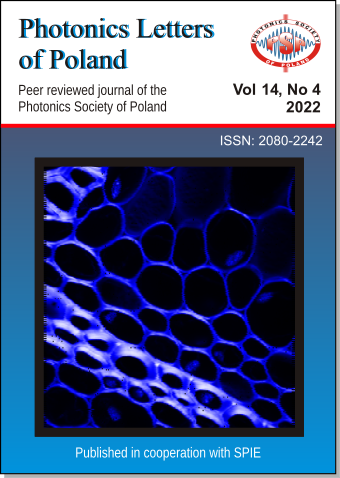
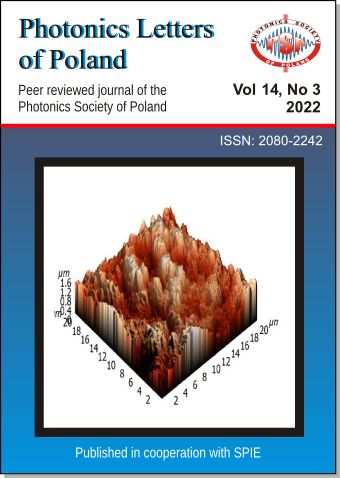
In the current issue of the Photonics Letters of Poland, one may find nine papers related to different aspects of photonics like: i) theoretical analysis of sensor structure based on the planar waveguide with a grating coupler to determine selected physical properties of blood; ii) AFM microscopy-based analysis of the influence of the oxidation method on the reduced graphene oxide; iii) microcrystalline diamond film evaluation by spectroscopic optical coherence tomography; iv) theoretical model of a planar broadband differential waveguide interferometer with gradient refractive index distribution; v) consideration of the color quality change when switching from fluorescent lamps to LEDs; vi) application of the 3D-FDTD method to design a refractive index sensor based on a slotted photonic crystal nanobeam cavity; vii) fabrication of a spot size expander using UV-curable resin on the end facet of a fiber with a high numerical aperture; viii) an experimental study of fiber-coupled fluorescence broadband light source suitable for spectroscopic applications; ix) analyzes the influence of the photo-polymerization process on the propagation properties of photonic crystal fiber filled with liquid crystalline mixture combined with reactive monomer and photoinitiator on the propagational properties. Eventually, the information about the 50th jubilee edition of the WILGA Symposium on Photonics Applications is given.
This issue was co-finaced in the frame of R&D Project "Stadion2" realized in the frame of agreement between Faculty of Physics, Warsaw University of Technology and SVT sp. z o. o. sp. k. from 29.11.2019.
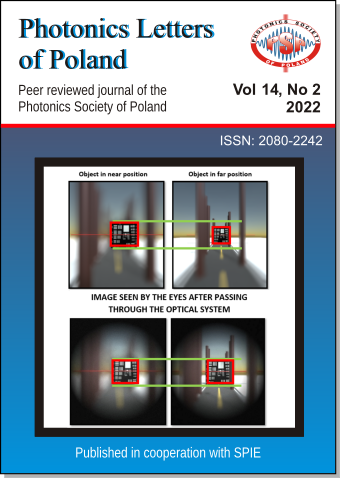
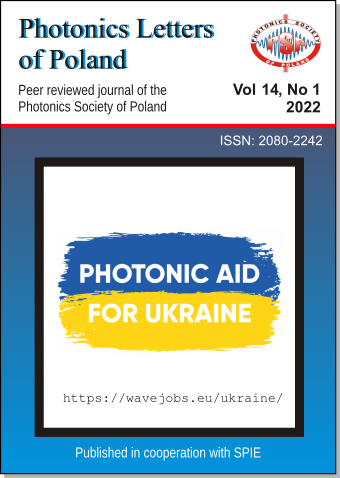
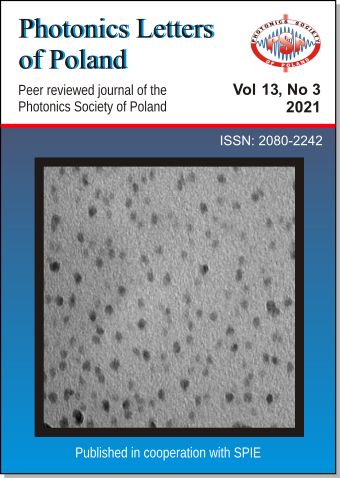
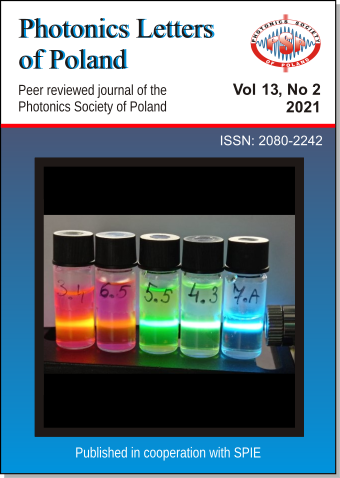
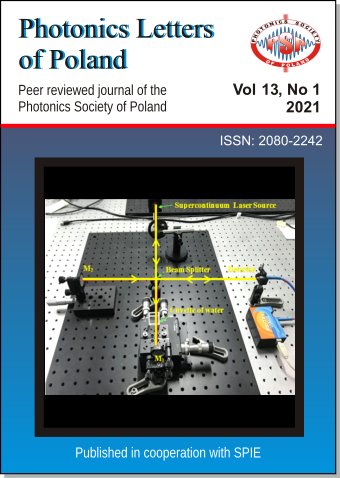
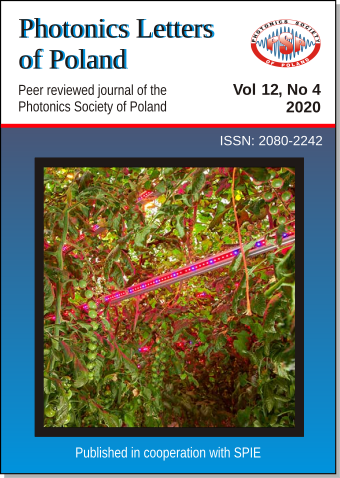
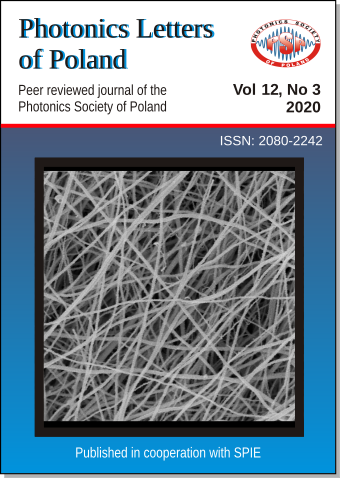
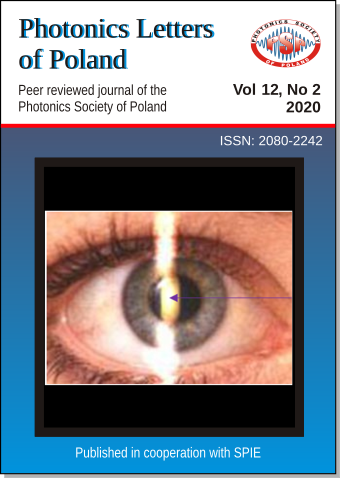
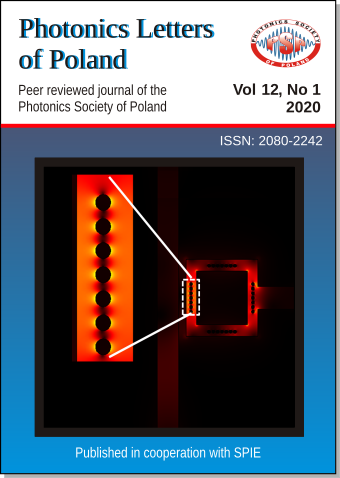
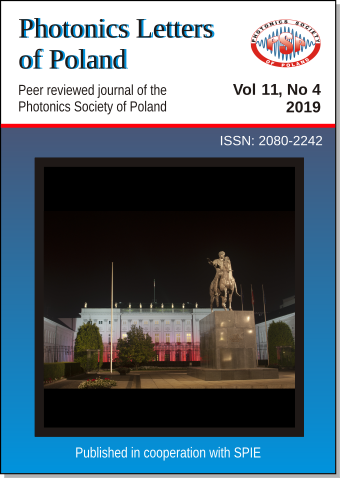
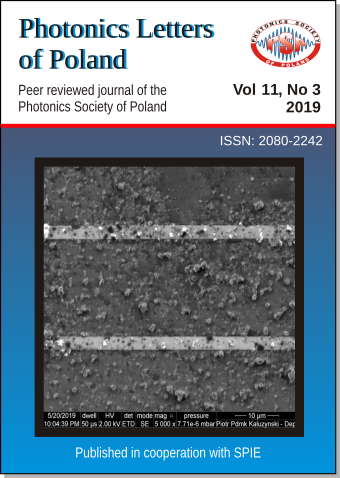
This issue was guest edited by Salvador X. Bara (Universidade de Santiago de Compostela) and Irena Fryc (Bialystok University of Technology).
The current issue of the Photonics Letters of Poland contains ten papers that describe many different aspects at photonics. There are papers about: Photometry and Multispectral Estimation (Univ. Santiago de Compostela, Univ. Murcia, Univ Complutense de Madrid), Entropy and Transmision (Univ. Estadual de Goiás, Univ. Paulista, Univ. Federal da Paraíba, Univ. Federal de Goiás), different Aspects of Light Pollution (Bialystok Univ. of Technology, Warsaw Univ. of technology and Lodz Univ. of Technology), Measurements of Sky Brightness (Krakow Univ. of Technology), Fiber Lasers (Military Univ. of Technol.), Conductive Polymers (Silesian Univ. of Technol.), and 3D Printing (Gdansk Univ. of Technol.). The papers give a flavor of selected research activities of Photonics Society of Poland Board members and their collaborators.
Journal Indicators:
CiteScore 2024 1.0
IF 0.8
H-index 19
SJR 0.265
Points on list of rated journals of the Ministry of Education and Science 40 (punkty z oficjalnej listy Ministerstwa Edukacji i Nauki )
